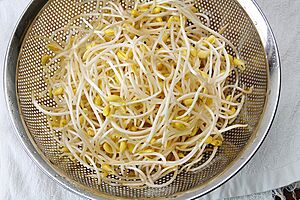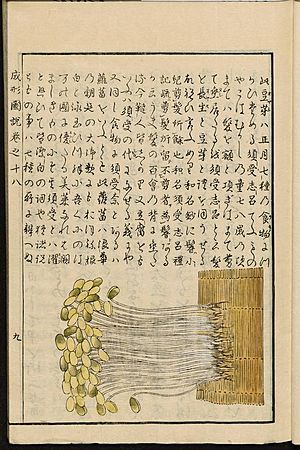Soybean sprout facts for kids
Quick facts for kids Soybean sprout |
|||||||||
|---|---|---|---|---|---|---|---|---|---|
 |
|||||||||
| Chinese name | |||||||||
| Traditional Chinese | 黃豆芽,黃芽白,大荳芽菜 | ||||||||
| Simplified Chinese | 黄豆芽 | ||||||||
| Literal meaning | yellow bean sprout | ||||||||
|
|||||||||
| Vietnamese name | |||||||||
| Vietnamese | giá đậu nành | ||||||||
| Korean name | |||||||||
| Hangul | 콩나물 | ||||||||
| Literal meaning | bean namul | ||||||||
|
|||||||||
| Japanese name | |||||||||
| Kanji | 豆萌やし | ||||||||
| Kana | まめもやし | ||||||||
|
|||||||||
| Malay name | |||||||||
| Malay | tauge kasar | ||||||||
| Indonesian name | |||||||||
| Indonesian | kecambah kacang kedelai | ||||||||
Soybean sprouts are a type of vegetable. They are made by letting soybeans grow tiny roots and shoots. You can grow them by keeping wet soybeans in the dark. Their roots will grow long and crunchy. Many countries in Asia grow and eat lots of soybean sprouts.
Contents
History of Soybean Sprouts
People think soybean sprouts have been eaten for a very long time. They might have been used since the Three Kingdoms of Korea period. An old medical book from the 1200s, called Emergency Folk Medicine Remedies, talks about growing kongnamul.
This book says that in the year 935, a general named Bae Hyeon-gyeong gave soybean sprouts to hungry soldiers. This happened when the Goryeo kingdom was being founded.
Later, a book from the Joseon period called Farm Management listed ways to cook soybean sprouts. Another Joseon book, Literary Miscellany of Seongho, mentioned that poor people used soybean sprouts to make juk (rice porridge). During times of hunger, soybean sprouts were a main food, as noted in the Complete Works of Cheongjanggwan.
How Soybean Sprouts Are Used in Cooking
Korean Dishes with Soybean Sprouts
Soybean sprouts are a very common food in Korean cuisine. In Korea, the word kongnamul (콩나물) means both the sprouts themselves and a seasoned vegetable dish made from them.
- Kongnamul Namul: This is a popular side dish. It can be made by stir-frying sprouts with sesame oil. It is also often served at special family events. Another way is kongnamul-muchim, where boiled sprouts are mixed with seasonings.
- Main Dishes: Soybean sprouts are used in many main meals. They are found in bibimbap, which is a mixed rice dish. They are also in jjim dishes, like agwi-jjim (braised angler fish).
- Rice and Soup: Sometimes, kongnamul-bap (rice cooked with sprouts) is eaten with soy sauce. A clear soup with sprouts is called kongnamul-guk. This soup can also be served cold in summer.
- Hangover Soup: Kongnamul-gukbap or kongnamul-haejangguk is a popular soup. It is often served in an earthenware pot. The rice is at the bottom, and the hot soup is poured over it.
- Modern Korean Food: Today, young people in South Korea enjoy kongnamul-bulgogi. This is a spicy pork dish with lots of soybean sprouts.
-
Kongnamul-bulgogi before cooking.
-
Red kongnamul-muchim (seasoned sprouts).
-
Bajirak-kongnamul-guk (clam and sprout soup).
-
Kongnamul-naengguk (cold sprout soup).
-
Kongnamul-gukbap (sprout hangover soup with rice).
-
Agwi-jjim made with soybean sprouts.
Nepalese Dishes with Soybean Sprouts
In Nepalese cuisine, there is a special soup called kwati. This soup is made from nine different types of sprouted beans. It is usually prepared for the Janai Purnima festival in August.
To make kwati, people fry onions, garlic, ginger, and potatoes. Then they add spices and bean sprouts, including soybean sprouts. Every family might have a slightly different recipe. Kwati is known as a very healthy food in Nepal. It is usually eaten with rice. Sometimes, fried goat meat is added to make the kwati even tastier.
See also
 In Spanish: Brote de soja para niños
In Spanish: Brote de soja para niños









